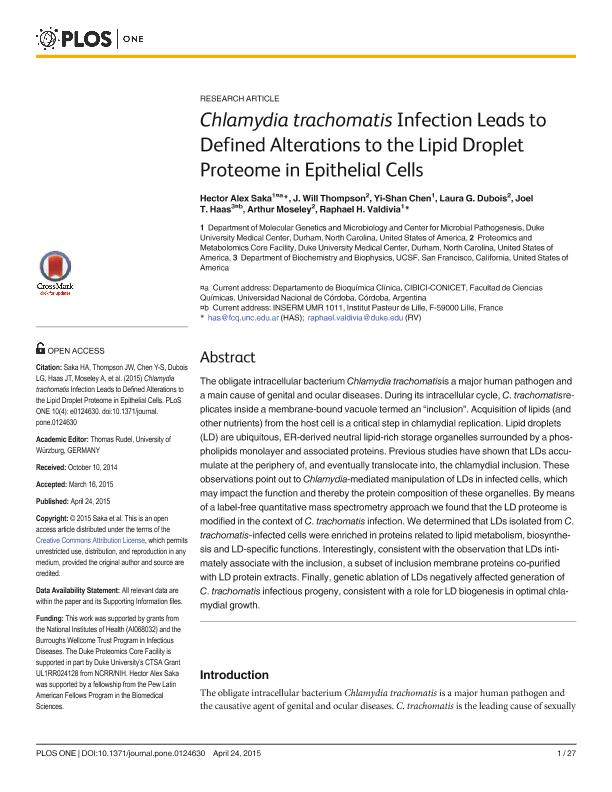Mostrar el registro sencillo del ítem
dc.contributor.author
Saka, Hector Alex

dc.contributor.author
Thompson, J. Will
dc.contributor.author
Chen, Yi-Shan
dc.contributor.author
Dubois, Laura G.
dc.contributor.author
Haas, Joel T.
dc.contributor.author
Moseley, Arthur
dc.contributor.author
Valdivia, Raphael H.
dc.date.available
2018-09-12T14:48:59Z
dc.date.issued
2015-04
dc.identifier.citation
Saka, Hector Alex; Thompson, J. Will; Chen, Yi-Shan; Dubois, Laura G.; Haas, Joel T.; et al.; Chlamydia trachomatis infection leads to defined alterations to the lipid droplet proteome in epithelial cells; Public Library of Science; Plos One; 10; 4; 4-2015
dc.identifier.issn
1932-6203
dc.identifier.uri
http://hdl.handle.net/11336/59274
dc.description.abstract
The obligate intracellular bacterium Chlamydia trachomatisis a major human pathogen and a main cause of genital and ocular diseases. During its intracellular cycle, C. trachomatisreplicates inside a membrane-bound vacuole termed an "inclusion". Acquisition of lipids (and other nutrients) from the host cell is a critical step in chlamydial replication. Lipid droplets (LD) are ubiquitous, ER-derived neutral lipid-rich storage organelles surrounded by a phospholipids monolayer and associated proteins. Previous studies have shown that LDs accumulate at the periphery of, and eventually translocate into, the chlamydial inclusion. These observations point out to Chlamydia-mediated manipulation of LDs in infected cells, which may impact the function and thereby the protein composition of these organelles. By means of a label-free quantitative mass spectrometry approach we found that the LD proteome is modified in the context of C. trachomatis infection. We determined that LDs isolated from C. trachomatis- infected cells were enriched in proteins related to lipid metabolism, biosynthesis and LD-specific functions. Interestingly, consistent with the observation that LDs intimately associate with the inclusion, a subset of inclusion membrane proteins co-purified with LD protein extracts. Finally, genetic ablation of LDs negatively affected generation of C. trachomatis infectious progeny, consistent with a role for LD biogenesis in optimal chlamydial growth.
dc.format
application/pdf
dc.language.iso
eng
dc.publisher
Public Library of Science

dc.rights
info:eu-repo/semantics/openAccess
dc.rights.uri
https://creativecommons.org/licenses/by-nc-sa/2.5/ar/
dc.subject
Chlamydia Trachomatis
dc.subject
Lipid Droplets
dc.subject
Host Pathogen Interactions
dc.subject
Quantitative Proteomics
dc.subject.classification
Otras Ciencias Biológicas

dc.subject.classification
Ciencias Biológicas

dc.subject.classification
CIENCIAS NATURALES Y EXACTAS

dc.title
Chlamydia trachomatis infection leads to defined alterations to the lipid droplet proteome in epithelial cells
dc.type
info:eu-repo/semantics/article
dc.type
info:ar-repo/semantics/artículo
dc.type
info:eu-repo/semantics/publishedVersion
dc.date.updated
2018-09-04T16:23:57Z
dc.journal.volume
10
dc.journal.number
4
dc.journal.pais
Estados Unidos

dc.journal.ciudad
San Francisco
dc.description.fil
Fil: Saka, Hector Alex. Universidad Nacional de Córdoba. Facultad de Ciencias Químicas. Departamento de Bioquímica Clínica; Argentina. University of Duke; Estados Unidos
dc.description.fil
Fil: Thompson, J. Will. Duke University Medical Center; Estados Unidos
dc.description.fil
Fil: Chen, Yi-Shan. Duke University Medical Center; Estados Unidos
dc.description.fil
Fil: Dubois, Laura G.. Duke University Medical Center; Estados Unidos
dc.description.fil
Fil: Haas, Joel T.. Dept. Of Biochemistry And Biophysics, Ucsf; Estados Unidos
dc.description.fil
Fil: Moseley, Arthur. Duke University Medical Center; Estados Unidos
dc.description.fil
Fil: Valdivia, Raphael H.. Duke University Medical Center; Estados Unidos
dc.journal.title
Plos One

dc.relation.alternativeid
info:eu-repo/semantics/altIdentifier/url/http://www.ncbi.nlm.nih.gov/pubmed/25909443
dc.relation.alternativeid
info:eu-repo/semantics/altIdentifier/doi/http://dx.doi.org/10.1371/journal.pone.0124630
Archivos asociados
